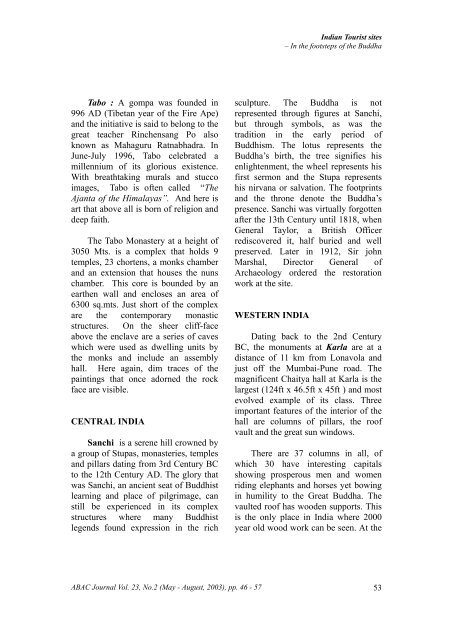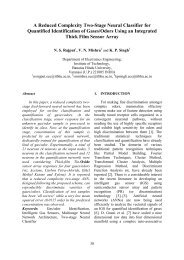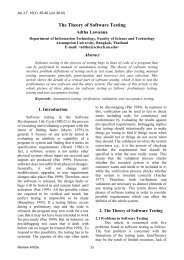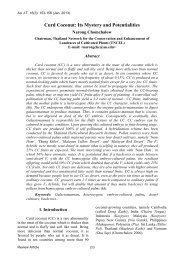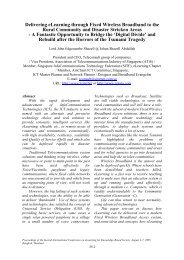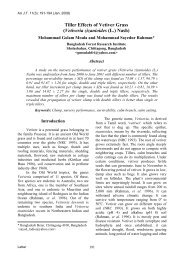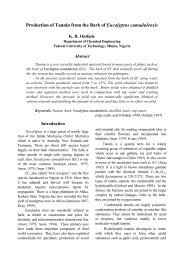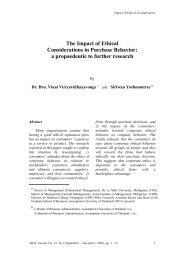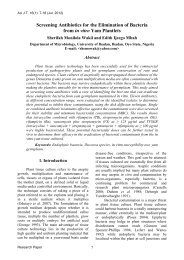Indian Tourist sites â In the footsteps of the Buddha - AU Journal ...
Indian Tourist sites â In the footsteps of the Buddha - AU Journal ...
Indian Tourist sites â In the footsteps of the Buddha - AU Journal ...
You also want an ePaper? Increase the reach of your titles
YUMPU automatically turns print PDFs into web optimized ePapers that Google loves.
<strong><strong>In</strong>dian</strong> <strong>Tourist</strong> <strong>sites</strong><br />
– <strong>In</strong> <strong>the</strong> <strong>footsteps</strong> <strong>of</strong> <strong>the</strong> <strong>Buddha</strong><br />
Tabo : A gompa was founded in<br />
996 AD (Tibetan year <strong>of</strong> <strong>the</strong> Fire Ape)<br />
and <strong>the</strong> initiative is said to belong to <strong>the</strong><br />
great teacher Rinchensang Po also<br />
known as Mahaguru Ratnabhadra. <strong>In</strong><br />
June-July 1996, Tabo celebrated a<br />
millennium <strong>of</strong> its glorious existence.<br />
With breathtaking murals and stucco<br />
images, Tabo is <strong>of</strong>ten called “The<br />
Ajanta <strong>of</strong> <strong>the</strong> Himalayas”. And here is<br />
art that above all is born <strong>of</strong> religion and<br />
deep faith.<br />
The Tabo Monastery at a height <strong>of</strong><br />
3050 Mts. is a complex that holds 9<br />
temples, 23 chortens, a monks chamber<br />
and an extension that houses <strong>the</strong> nuns<br />
chamber. This core is bounded by an<br />
ear<strong>the</strong>n wall and encloses an area <strong>of</strong><br />
6300 sq.mts. Just short <strong>of</strong> <strong>the</strong> complex<br />
are <strong>the</strong> contemporary monastic<br />
structures. On <strong>the</strong> sheer cliff-face<br />
above <strong>the</strong> enclave are a series <strong>of</strong> caves<br />
which were used as dwelling units by<br />
<strong>the</strong> monks and include an assembly<br />
hall. Here again, dim traces <strong>of</strong> <strong>the</strong><br />
paintings that once adorned <strong>the</strong> rock<br />
face are visible.<br />
CENTRAL INDIA<br />
Sanchi is a serene hill crowned by<br />
a group <strong>of</strong> Stupas, monasteries, temples<br />
and pillars dating from 3rd Century BC<br />
to <strong>the</strong> 12th Century AD. The glory that<br />
was Sanchi, an ancient seat <strong>of</strong> Buddhist<br />
learning and place <strong>of</strong> pilgrimage, can<br />
still be experienced in its complex<br />
structures where many Buddhist<br />
legends found expression in <strong>the</strong> rich<br />
sculpture. The <strong>Buddha</strong> is not<br />
represented through figures at Sanchi,<br />
but through symbols, as was <strong>the</strong><br />
tradition in <strong>the</strong> early period <strong>of</strong><br />
Buddhism. The lotus represents <strong>the</strong><br />
<strong>Buddha</strong>’s birth, <strong>the</strong> tree signifies his<br />
enlightenment, <strong>the</strong> wheel represents his<br />
first sermon and <strong>the</strong> Stupa represents<br />
his nirvana or salvation. The footprints<br />
and <strong>the</strong> throne denote <strong>the</strong> <strong>Buddha</strong>’s<br />
presence. Sanchi was virtually forgotten<br />
after <strong>the</strong> 13th Century until 1818, when<br />
General Taylor, a British Officer<br />
rediscovered it, half buried and well<br />
preserved. Later in 1912, Sir john<br />
Marshal, Director General <strong>of</strong><br />
Archaeology ordered <strong>the</strong> restoration<br />
work at <strong>the</strong> site.<br />
WESTERN INDIA<br />
Dating back to <strong>the</strong> 2nd Century<br />
BC, <strong>the</strong> monuments at Karla are at a<br />
distance <strong>of</strong> 11 km from Lonavola and<br />
just <strong>of</strong>f <strong>the</strong> Mumbai-Pune road. The<br />
magnificent Chaitya hall at Karla is <strong>the</strong><br />
largest (124ft x 46.5ft x 45ft ) and most<br />
evolved example <strong>of</strong> its class. Three<br />
important features <strong>of</strong> <strong>the</strong> interior <strong>of</strong> <strong>the</strong><br />
hall are columns <strong>of</strong> pillars, <strong>the</strong> ro<strong>of</strong><br />
vault and <strong>the</strong> great sun windows.<br />
There are 37 columns in all, <strong>of</strong><br />
which 30 have interesting capitals<br />
showing prosperous men and women<br />
riding elephants and horses yet bowing<br />
in humility to <strong>the</strong> Great <strong>Buddha</strong>. The<br />
vaulted ro<strong>of</strong> has wooden supports. This<br />
is <strong>the</strong> only place in <strong>In</strong>dia where 2000<br />
year old wood work can be seen. At <strong>the</strong><br />
ABAC <strong>Journal</strong> Vol. 23, No.2 (May - August, 2003), pp. 46 - 57 53


